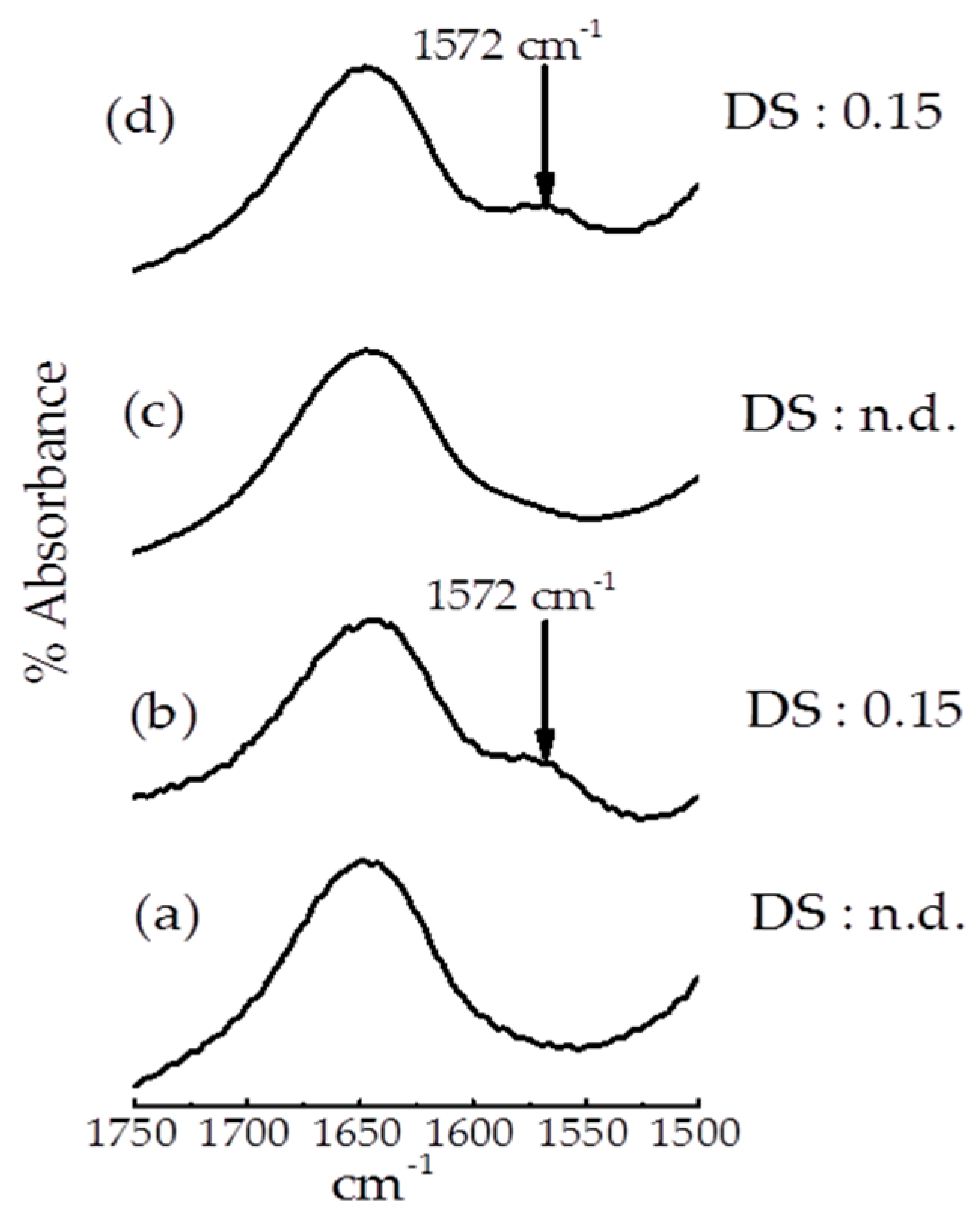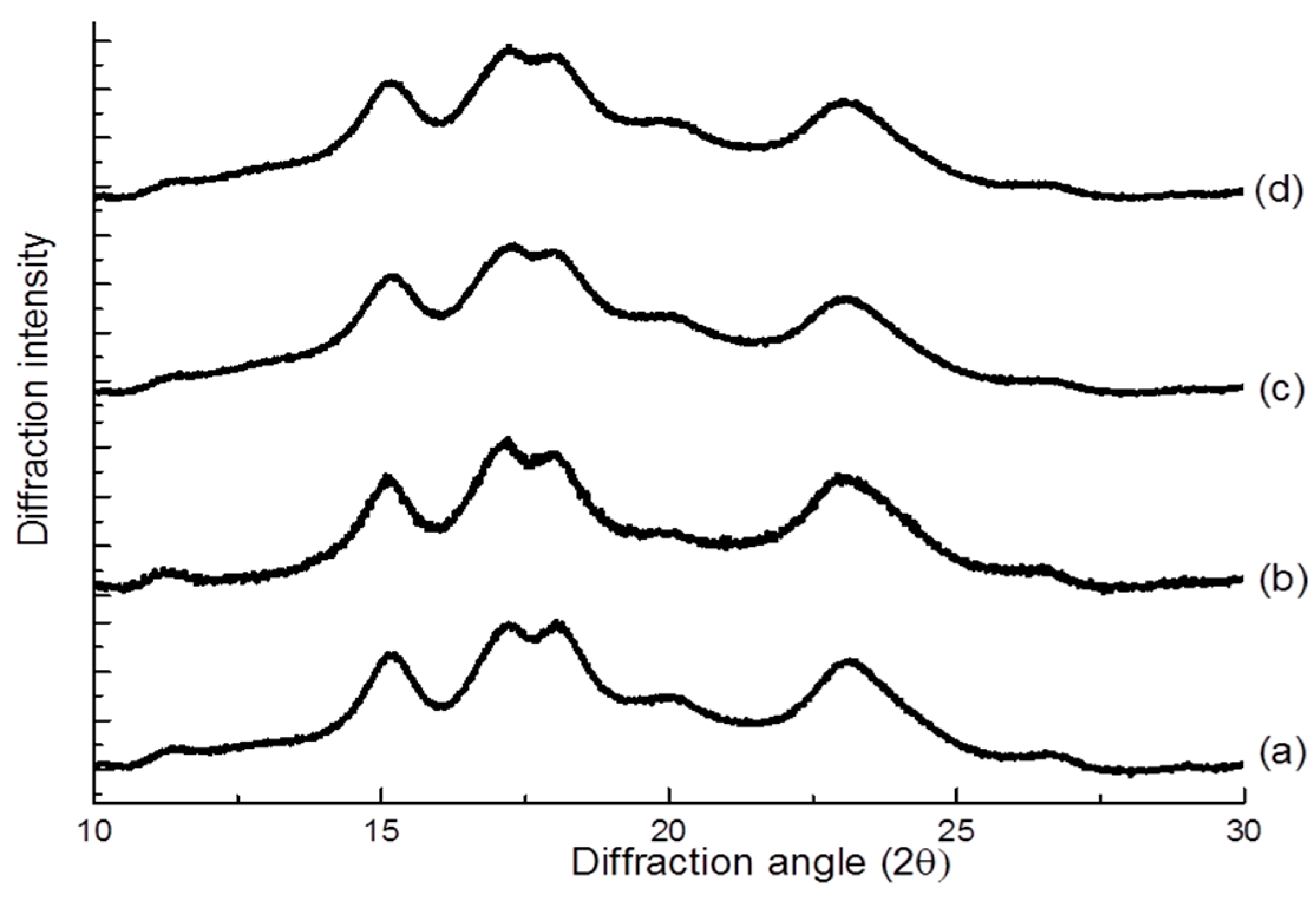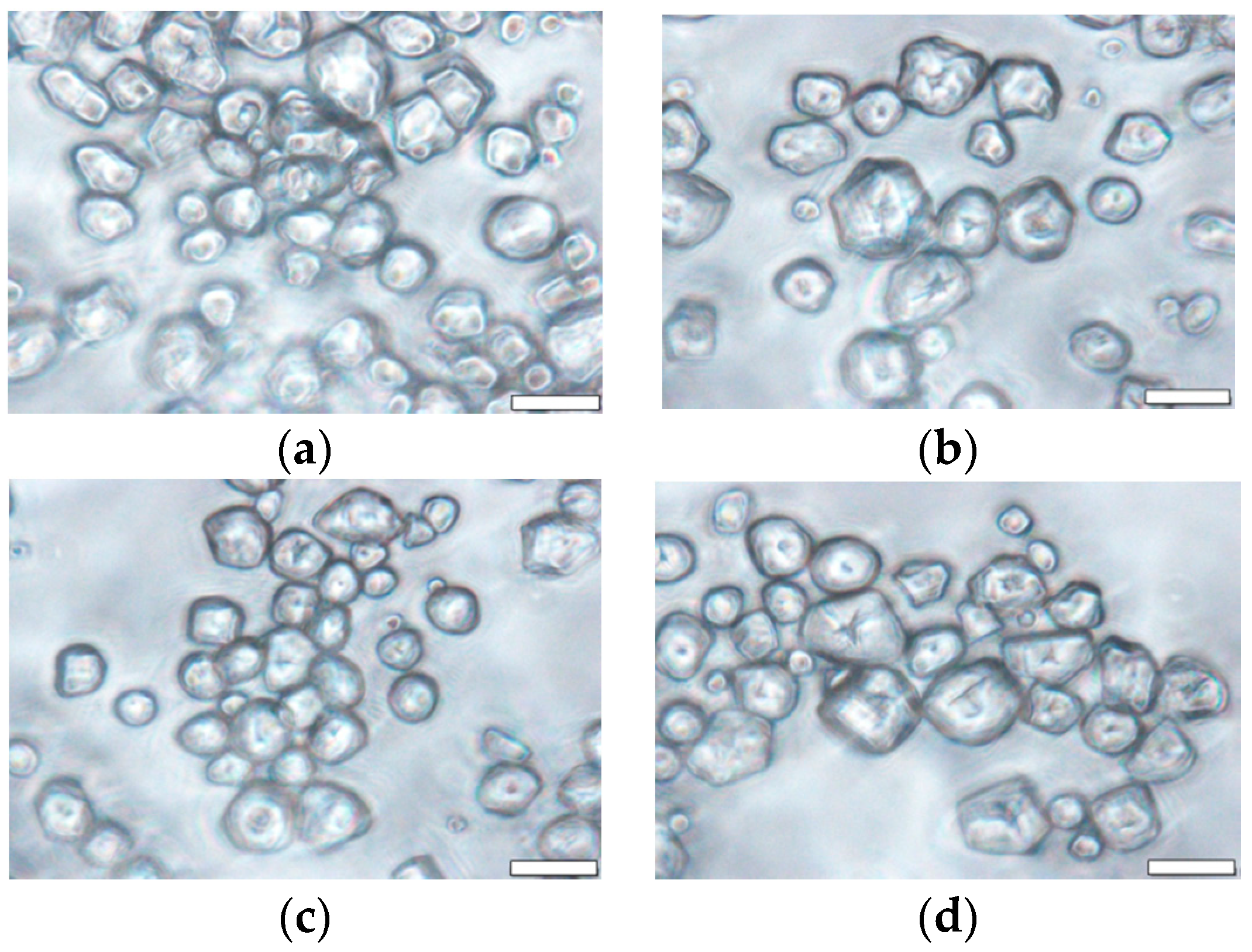Effects of Dual Modification with Succinylation and Annealing on Physicochemical, Thermal and Morphological Properties of Corn Starch
Abstract
1. Introduction
2. Materials and Methods
2.1. Materials
2.2. Succinylation Process
2.3. Annealing Process
2.4. Dual Modification Process
2.5. Fourier-Transform Infrared (FTIR) Spectroscopy
2.6. Degree of Substitution (DS)
2.7. Water-Binding Capacity (WBC)
2.8. Swelling Power and Solubility
2.9. Paste Clarity
2.10. Pasting Properties
2.11. Differential Scanning Calorimetry (DSC)
2.12. X-ray Diffraction Pattern
2.13. Morphological Properties
2.14. Statistical Analyses
3. Results and Discussion
3.1. FTIR Spectroscopy and DS
3.2. Water Binding Capacity (WBC)
3.3. Swelling Power and Solubility
3.4. Paste Clarity
3.5. Pasting Properties
3.6. Thermal Properties
3.7. X-ray Diffraction Pattern
3.8. Morphological Properties
4. Conclusions
Author Contributions
Conflicts of Interest
References
- Chi, H.; Xu, K.; Wu, X.; Chen, Q.; Xue, D.; Song, C.; Zhang, W.; Wang, P. Effect of acetylation on the properties of corn starch. Food Chem. 2008, 106, 923–928. [Google Scholar] [CrossRef]
- Arocas, A.; Sanz, T.; Fiszman, S.M. Improving effect of xanthan and locust bean gums on the freeze-thaw stability of white sauces made with different native starches. Food Hydrocoll. 2009, 23, 2478–2484. [Google Scholar] [CrossRef]
- Liu, J.; Wang, B.; Lin, L.; Zhang, J.; Liu, W.; Xie, J.; Ding, Y. Functional, physicochemical properties and structure of cross-linked oxidized maize starch. Food Hydrocoll. 2014, 36, 45–52. [Google Scholar] [CrossRef]
- Jayakody, L.; Hoover, R. Effect of annealing on the molecular structure and physicochemical properties of starches from different botanical origins—A review. Carbohydr. Polym. 2008, 74, 691–703. [Google Scholar] [CrossRef]
- Xiao, H.X.; Lin, Q.L.; Liu, G.Q.; Yu, F.X. A comparative study of the characteristics of cross-linked, oxidized and dual-modified rice starches. Molecules 2012, 17, 10946–10957. [Google Scholar] [CrossRef] [PubMed]
- Zavareze, E.D.R.; Dias, A.R.G. Impact of heat-moisture treatment and annealing in starches: A review. Carbohydr. Polym. 2011, 83, 317–328. [Google Scholar] [CrossRef]
- Lawal, O.S. Succinylated Dioscorea cayenensis starch: Effect of reaction parameters and characterisation. Starch/Staerke 2012, 64, 145–156. [Google Scholar] [CrossRef]
- Olayinka, O.O.; Olu-Owolabi, B.I.; Adebowale, K.O. Effect of succinylation on the physicochemical, rheological, thermal and retrogradation properties of red and white sorghum starches. Food Hydrocoll. 2011, 25, 515–520. [Google Scholar] [CrossRef]
- Chi, H.; Xu, K.; Xue, D.; Song, C.; Zhang, W.; Wang, P. Synthesis of dodecenyl succinic anhydride (DDSA) corn starch. Food Res. Int. 2007, 40, 232–238. [Google Scholar] [CrossRef]
- Moin, A.; Ali, T.M.; Hasnain, A. Effect of succinylation on functional and morphological properties of starches from broken kernels of Pakistani Basmati and Irri rice cultivars. Food Chem. 2016, 191, 52–58. [Google Scholar] [CrossRef] [PubMed]
- Bhandari, P.N.; Singhal, R.S. Effect of succinylation on the corn and amaranth starch pastes. Carbohydr. Polym. 2002, 48, 233–240. [Google Scholar] [CrossRef]
- Ačkar, D.; Babić, J.; Jozinović, A.; Miličević, B.; Jokić, S.; Miličević, R.; Rajič, M.; Šubarić, D. Starch modification by organic acids and their derivatives: A review. Molecules 2015, 20, 19554–19570. [Google Scholar] [CrossRef] [PubMed]
- Hoover, R.; Vasanthan, T. The effect of annealing on the physicochemical properties of wheat, oat, potato and lentil starches. J. Food Biochem. 1994, 17, 303–325. [Google Scholar] [CrossRef]
- Wang, S.; Wang, J.; Yu, J.; Wang, S. A comparative study of annealing of waxy, normal and high-amylose maize starches: The role of amylose molecules. Food Chem. 2014, 164, 332–338. [Google Scholar] [CrossRef] [PubMed]
- Dias, A.R.G.; da Rosa Zavareze, E.; Spier, F.; de Castro, L.A.S.; Gutkoski, L.C. Effects of annealing on the physicochemical properties and enzymatic susceptibility of rice starches with different amylose contents. Food Chem. 2010, 123, 711–719. [Google Scholar] [CrossRef]
- Rocha, T.S.; Felizardo, S.G.; Jane, J.L.; Franco, C.M.L. Effect of annealing on the semicrystalline structure of normal and waxy corn starches. Food Hydrocoll. 2012, 29, 93–99. [Google Scholar] [CrossRef]
- Singh, H.; Chang, Y.H.; Lin, J.H.; Singh, N.; Singh, N. Influence of heat-moisture treatment and annealing on functional properties of sorghum starch. Food Res. Int. 2011, 44, 2949–2954. [Google Scholar] [CrossRef]
- Jacobs, H.; Delcour, J.A. Hydrothermal Modifications of Granular Starch, with Retention of the Granular Structure: A Review. J. Agric. Food Chem. 1998, 46, 2895–2905. [Google Scholar] [CrossRef]
- Waduge, R.N.; Hoover, R.; Vasanthan, T.; Gao, J.; Li, J. Effect of annealing on the structure and physicochemical properties of barley starches of varying amylose content. Food Res. Int. 2006, 39, 59–77. [Google Scholar] [CrossRef]
- Hoover, R.; Vasanthan, T. The flow properties of native heat-moisture treated, and annealed starches from wheat, oat, potato and lentil. J. Food Biochem. 1994, 18, 67–82. [Google Scholar] [CrossRef]
- Hormdok, R.; Noomhorm, A. Hydrothermal treatments of rice starch for improvement of rice noodle quality. LWT-Food Sci. Technol. 2007, 40, 1723–1731. [Google Scholar] [CrossRef]
- Adebowale, K.O.; Olu-Owolabi, B.I.; Olayinka, O.O.; Lawal, O.S. Effect of heat moisture treatment and annealing on physicochemical properties of red sorghum starch. Afr. J. Biotechnol. 2005, 4, 928–933. [Google Scholar]
- Gomes, A.M.M.; Mendes Da Silva, C.E.; Ricardo, N.M.P.S.; Sasaki, J.M.; Germani, R. Impact of annealing on the physicochemical properties of unfermented cassava starch (“polvilho doce”). Starch/Staerke 2004, 56, 419–423. [Google Scholar] [CrossRef]
- Lan, H.; Hoover, R.; Jayakody, L.; Liu, Q.; Donner, E.; Baga, M.; Asare, E.K.; Hucl, P.; Chibbar, R.N. Impact of annealing on the molecular structure and physicochemical properties of normal, waxy and high amylose bread wheat starches. Food Chem. 2008, 111, 663–675. [Google Scholar] [CrossRef]
- Corke, H.; Wu, H.; Yue, S.; Sun, H. Developing Specialty Starches from New Crops A Case Study Using Grain Amaranth. In Cereals; Campbell, G.M., Webb, C., Mckee, S.L., Eds.; Springer: Boston, MA, USA, 1997; pp. 91–102. ISBN 978-1-4757-2675-6. [Google Scholar]
- Shafie, B.; Cheng, S.C.; Lee, H.H.; Yiu, P.H. Characterization and classification of whole-grain rice based on rapid visco analyzer (RVA) pasting profile. Int. Food Res. J. 2016, 23, 2138–2143. [Google Scholar]
- Yadav, B.S.; Guleria, P.; Yadav, R.B. Hydrothermal modification of Indian water chestnut starch: Influence of heat-moisture treatment and annealing on the physicochemical, gelatinization and pasting characteristics. LWT-Food Sci. Technol. 2013, 53, 211–217. [Google Scholar] [CrossRef]
- Vamadevan, V.; Bertoft, E.; Soldatov, D.V.; Seetharaman, K. Impact on molecular organization of amylopectin in starch granules upon annealing. Carbohydr. Polym. 2013, 98, 1045–1055. [Google Scholar] [CrossRef] [PubMed]
- Gbenga, B.L.; Olakunle, O.; Adedayo, A.M. Influence of pregelatinization on the physicochemical and compressional characteristics of starches obtained from two local varieties of Dioscorea rotundata. IOSR J. Pharm. 2014, 4, 24–32. [Google Scholar] [CrossRef]
- Jyothi, A.N.; Rajasekharan, K.N.; Moorthy, S.N.; Sreekumar, J. Synthesis and characterization of low DS succinate derivatives of cassava (Manihot esculenta Crantz) starch. Starch/Staerke 2005, 57, 319–324. [Google Scholar] [CrossRef]
- Abbey, B.W.; Ibeh, G.O. Functional Properties of Raw and Heat Processed Cowpea (Vigna unguiculata, Walp) Flour. J. Food Sci. 1988, 53, 1775–1777. [Google Scholar] [CrossRef]
- Waliszewski, K.N.; Aparicio, M.A.; Bello, L.A.; Monroy, J.A. Changes of banana starch by chemical and physical modification. Carbohydr. Polym. 2003, 52, 237–242. [Google Scholar] [CrossRef]
- Bhandari, P.N.; Singhal, R.S. Studies on the optimisation of preparation of succinate derivatives from corn and amaranth starches. Carbohydr. Polym. 2002, 47, 277–283. [Google Scholar] [CrossRef]
- Wang, S.; Wang, J.; Wang, S.; Wang, S. Annealing improves paste viscosity and stability of starch. Food Hydrocoll. 2017, 62, 203–211. [Google Scholar] [CrossRef]
- Thao, H.M.; Noomhorm, A. Physiochemical Properties of Sweet Potato and Mung Bean Starch and Their Blends for Noodle Production. J. Food Process. Technol. 2011, 2, 1–9. [Google Scholar] [CrossRef]
- Nagaoka, S.; Tobata, H.; Takiguchi, Y.; Satoh, T.; Sakurai, T.; Takafuji, M.; Ihara, H. Characterization of cellulose microbeads prepared by a viscose-phase-separation method and their chemical modification with acid anhydride. J. Appl. Polym. Sci. 2005, 97, 149–157. [Google Scholar] [CrossRef]
- Zhang, Y.; Jin, R.; Zhang, L.; Liu, M. Growth of CaCO3 in the templated Langmuir-Blodgett film of a bolaamphiphilic diacid. New J. Chem. 2004, 28, 614–617. [Google Scholar] [CrossRef]
- Ali, T.M.; Hasnain, A. Effect of Annealing on Morphological and Functional Properties of Pakistani White Sorghum (Sorghum bicolor) Starch. J. Basic Appl. Sci. 2016, 12, 358–364. [Google Scholar] [CrossRef]
- Arueya, G.L.; Oyewale, T.M. Effect of varying degrees of succinylation on the functional and morphological properties of starch from acha (Digitaria exilis Kippis Stapf). Food Chem. 2015, 177, 258–266. [Google Scholar] [CrossRef] [PubMed]
- Sasaki, T.; Matsuki, J. Effect of wheat starch structure on swelling power. Cereal Chem. 1998, 75, 525–529. [Google Scholar] [CrossRef]
- Tester, R.F.; Morrison, W.R. Swelling and gelatinization of cereal starches. I. Effects of amylopectin, amylose, and lipids. Cereal Chem. 1990, 67, 551–557. [Google Scholar]
- Tester, R.F.; Debon, S.J.J.; Sommerville, M.D. Annealing of maize starch. Carbohydr. Polym. 2000, 42, 287–299. [Google Scholar] [CrossRef]
- Lawal, O.S. Succinyl and acetyl starch derivatives of a hybrid maize: Physicochemical characteristics and retrogradation properties monitored by differential scanning calorimetry. Carbohydr. Res. 2004, 339, 2673–2682. [Google Scholar] [CrossRef] [PubMed]
- Perera, C.; Hoover, R. Influence of hydroxypropylation on retrogradation properties of native, defatted and heat-moisture treated potato starches. Food Chem. 1999, 64, 361–375. [Google Scholar] [CrossRef]
- Ruan, H.; Chen, Q.; Fu, M.; Xu, Q.; He, G. Preparation and properties of octenyl succinic anhydride modified potato starch. Food Chem. 2009, 114, 81–86. [Google Scholar] [CrossRef]
- Awokoya, K.N.; Nwokocha, L.M.; Moronkola, B.A.; Moronkola, D.O. Studies on the isolation, structural and functional properties of Starch Succinate of Cocoyam (Colocasia antiquorum). Der Chem. Sin. 2011, 2, 228–244. [Google Scholar]
- Chen, H.M.; Huang, Q.; Fu, X.; Luo, F.X. Ultrasonic effect on the octenyl succinate starch synthesis and substitution patterns in starch granules. Food Hydrocoll. 2014, 35, 636–643. [Google Scholar] [CrossRef]
- Van Der Burgt, Y.E.M.; Bergsma, J.; Bleeker, I.P.; Mijland, P.J.H.C.; Van Der Kerk-van Hoof, A.; Kamerling, J.P.; Vliegenthart, J.F.G. Distribution of methyl substituents in amylose and amylopectin from methylated potato starches. Carbohydr. Res. 2000, 325, 183–191. [Google Scholar] [CrossRef]
- Tester, R.F.; Debon, S.J.J. Annealing of starch—A review. Int. J. Biol. Macromol. 2000, 27, 1–12. [Google Scholar] [CrossRef]
- Alcázar-Alay, S.C.; Meireles, M.A.A. Physicochemical properties, modifications and applications of starches from different botanical sources. Food Sci. Technol. 2015, 35, 215–236. [Google Scholar] [CrossRef]
- Qi, X.; Tester, R.F.; Snape, C.E.; Yuryev, V.; Wasserman, L.A.; Ansell, R. Molecular basis of the gelatinization and swelling characteristics of waxy barley starches grown in the same location during the same season. Part II. Crystallinity and gelatinization characteristics. J. Cereal Sci. 2004, 39, 57–66. [Google Scholar] [CrossRef]
- Hoover, R.; Vasanthan, T. Effect of heat-moisture treatment on the structure and physicochemical properties of cereal, legume, and tuber starches. Carbohydr. Res. 1994, 252, 33–53. [Google Scholar] [CrossRef]
- Tester, R.F.; Debon, S.J.J.; Karkalas, J. Annealing of wheat starch. J. Cereal Sci. 1998, 28, 259–272. [Google Scholar] [CrossRef]
- Chung, H.J.; Liu, Q.; Hoover, R. Impact of annealing and heat-moisture treatment on rapidly digestible, slowly digestible and resistant starch levels in native and gelatinized corn, pea and lentil starches. Carbohydr. Polym. 2009, 75, 436–447. [Google Scholar] [CrossRef]
- O’Brien, S.; Wang, Y.J. Susceptibility of annealed starches to hydrolysis by α-amylase and glucoamylase. Carbohydr. Polym. 2008, 72, 597–607. [Google Scholar] [CrossRef]
- Liu, H.; Yu, L.; Simon, G.; Zhang, X.; Dean, K.; Chen, L. Effect of annealing and pressure on microstructure of corn starches with different amylose/amylopectin ratios. Carbohydr. Res. 2009, 344, 350–354. [Google Scholar] [CrossRef] [PubMed]
- Emeje, M.; Kalita, R.; Isimi, C.; Buragohain, A.; Kunle, O.; Ofoefule, S. Synthesis, physicochemical characterization, and Functional properties of an esterified starch from an underutilized source in Nigeria. Afr. J. Food Agric. Nutr. Dev. 2012, 12, 27–31. [Google Scholar] [CrossRef]
- Ayucitra, A. Preparation and Characterisation of Acetylated Corn Starches. Int. J. Chem. Eng. Appl. 2012, 3, 156–159. [Google Scholar] [CrossRef]
- Kiseleva, V.I.; Genkina, N.K.; Tester, R.; Wasserman, L.A.; Popov, A.A.; Yuryev, V.P. Annealing of normal, low and high amylose starches extracted from barley cultivars grown under different environmental conditions. Carbohydr. Polym. 2004, 56, 157–168. [Google Scholar] [CrossRef]



| Sample | WBC (g g−1) | Paste Clarity (%) | Swelling Power (g g−1) | Solubility (%) |
|---|---|---|---|---|
| Native | 0.69 ± 0.03 b | 65.4 ± 0.5 c | 16.4 ± 0.2 b | 11.2 ± 0.2 a,b |
| Succinylated | 0.84 ± 0.01 a | 72.9 ± 1.3 a | 17.3 ± 0.2 a,b | 12.7 ± 1.2 a |
| Annealed | 0.66 ± 0.02 c | 67.4 ± 0.7 a,b | 14.2 ± 0.4 c | 9.7 ± 0.6 b |
| Dual Modified | 0.83 ± 0.01 a | 68.6 ± 0.5 b | 17.7 ± 0.4 a | 11.1 ± 0.8 a,b |
| Sample | Peak Viscosity (mPas) | Trough Viscosity (mPas) | Breakdown Viscosity (mPas) | Relative Breakdown | Stability Ratio |
|---|---|---|---|---|---|
| Native | 2707 ± 43 c | 1737 ± 37 c | 970 ± 33 b | 0.36 ± 0.01 c | 0.64 ± 0.01 b |
| Succinylated | 4111 ± 258 a | 2414 ± 42 a | 1697 ± 165 a | 0.42 ± 0.02 b | 0.58 ± 0.02 c |
| Annealed | 2650 ± 49 c | 1168 ± 104 d | 1481 ± 31 a | 0.56 ± 0.01 a | 0.44 ± 0.01 d |
| Dual modified | 3171 ± 14 b | 2188 ± 20 b | 982 ± 13 b | 0.31 ± 0.004 d | 0.69 ± 0.004 a |
| Sample | To (°C) | Tp (°C) | Tc (°C) | ∆H (mJ g−1) |
|---|---|---|---|---|
| Native | 66.8 ± 0.2 a | 73.5 ± 0.5 a | 81.7 ± 0.3 b | 7.9 ± 0.3 b |
| Succinylated | 67.2 ± 1.1 a | 74.0 ± 0.4 a | 82.0 ± 0.05 a,b | 9.2 ± 0.9 a,b |
| Annealed | 70.9 ± 0.1 b | 75.4 ± 0.1 b | 82.4 ± 0.1 a,b | 8.2 ± 0.5 a,b |
| Dual modified | 67.6 ± 0.6 a | 74.1 ± 0.4 a | 82.6 ± 0.5 a | 9.7 ± 0.5 a |
© 2018 by the authors. Licensee MDPI, Basel, Switzerland. This article is an open access article distributed under the terms and conditions of the Creative Commons Attribution (CC BY) license (http://creativecommons.org/licenses/by/4.0/).
Share and Cite
Ariyantoro, A.R.; Katsuno, N.; Nishizu, T. Effects of Dual Modification with Succinylation and Annealing on Physicochemical, Thermal and Morphological Properties of Corn Starch. Foods 2018, 7, 133. https://doi.org/10.3390/foods7090133
Ariyantoro AR, Katsuno N, Nishizu T. Effects of Dual Modification with Succinylation and Annealing on Physicochemical, Thermal and Morphological Properties of Corn Starch. Foods. 2018; 7(9):133. https://doi.org/10.3390/foods7090133
Chicago/Turabian StyleAriyantoro, Achmad Ridwan, Nakako Katsuno, and Takahisa Nishizu. 2018. "Effects of Dual Modification with Succinylation and Annealing on Physicochemical, Thermal and Morphological Properties of Corn Starch" Foods 7, no. 9: 133. https://doi.org/10.3390/foods7090133
APA StyleAriyantoro, A. R., Katsuno, N., & Nishizu, T. (2018). Effects of Dual Modification with Succinylation and Annealing on Physicochemical, Thermal and Morphological Properties of Corn Starch. Foods, 7(9), 133. https://doi.org/10.3390/foods7090133





